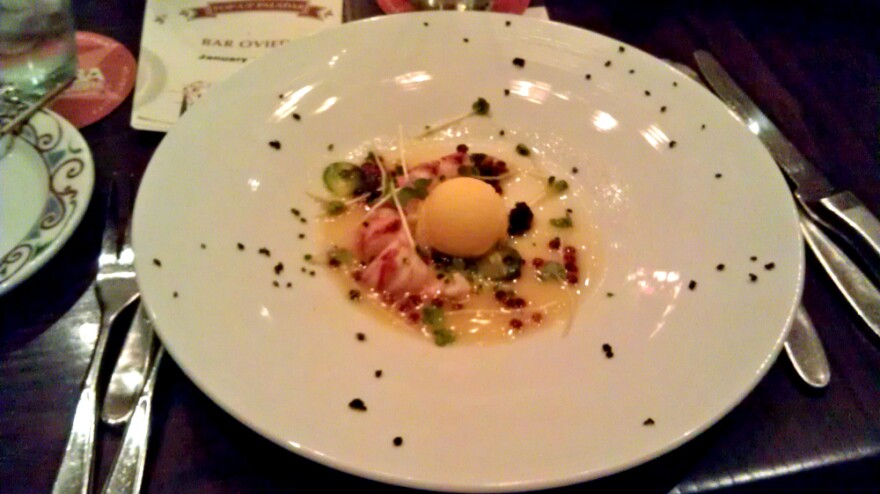Ham sandwiches, hot-pressed and gooey with cheese. Neat piles of black beans and rice. Grilled chicken.
This is the simple, filling fare served at Cuban restaurants around the world. And like the iconic, rusty Studebakers that line the streets of Havana, Cuban food hasn't changed much since the 1950s. The communist government's stranglehold on the economy and its citizens' travel, combined with the U.S. trade embargo, has meant that Cuban chefs haven't picked up the modern cooking techniques, or exotic ingredients, that have invigorated the cuisines of much of the rest of the world.
But that, according to some chefs, is starting to change. This month, I got a taste of some of the most innovative cooking in Cuba. Luckily, I didn't have to fly to Cuba to try it. For the first time since the embargo against Cuba was imposed in 1960, a Cuban chef came to the U.S. to cook for Americans.
Luis Alberto Alfonso Pérez, who goes by Lucio, is a strapping bearded chef who runs El Gijonés restaurant in Havana. In 2010, he met Guillermo Pernot, the James Beard award-winning chef behind the successful Cuba Libre chain in the U.S. Pernot, who's Argentine but learned to cook Cuban food from his Cuban wife, went to Havana, determined to discover something that might inspire his own cooking.
Instead, he was pleasantly surprised to meet a handful of chefs, including Lucio, who are trying to take their country's cuisine to the next level. "They want to do it, but they don't really have the ingredients," says Pernot. "But you can see they are trying to experiment with different styles. Some are now using cold smoking and steaming – these are not traditional techniques in Cuban cooking – and they're using new cuts of meat."
He thought diners outside of Cuba should get to know these chefs, so he decided to bring them, one by one, to Cuba Libre's Washington, D.C., branch for a series of pop-up paladares — a term used to describe Cuba's privately owned, usually family-run restaurants.
"I thought, people are bringing Cuban musicians and artists to the U.S. Why can't we do it with chefs?" Pernot tells The Salt.
It was clear from Lucio's first course, prepared for those of us assembled in the restaurant's back room, that this would be an unquestionably 21st century Cuban meal: lobster carpaccio salad was paired with pineapple sorbet and topped with truffle oil-infused sesame seeds.
Truffles, of course, are not readily available in Cuba. Even though more than 70 percent of the island's food is imported, much of it is commodities like chicken and grain. Specialty items are breathtakingly expensive and out of reach even for chefs; the few that enter the country are often smuggled in suitcases by visiting relatives.
The local supply of fresh produce isn't especially reliable, either. Lucio says he frequently has to go two weeks without potatoes — a nettlesome problem, given that they're a fixture on his menu.
After the lobster, Lucio teased us with a twist on ropa vieja — a quintessential Cuban dish of pulled beef, named for the old rags it resembles. Lucio's ropa vieja was a marvel, made of lamb, wrapped in a thin layer of eggplant and doused with a minty broth. Next, he served the kind of dish he can usually only fantasize about in his Cuban kitchen: baby wild boar rib chops, with sour orange-cinnamon compote and a tamal made from yuca.
This was actually the most traditional off all the dishes on the menu, and yet the hardest for Lucio to execute in Cuba. Why? Because wild boar is now so scarce on the island, he says.
"When Lucio saw the wild boar I was able to get him here, he said, 'Oh my god, this is so beautiful," says Pernot. "So I've got to find a way to get more of it to him." Pernot isn't kidding. He's looking into ways to send Lucio 500 pounds of wild boar in a shipping container, enough to last him a few months.
Lucio's meal was capped with a cheese flan, made modern with a sprinkling of garlic confit on top and a small pool of guava coulis. Three out of four courses featured the vibrant fruits of Cuba — pineapple, orange and guava — paired with savory flavors: unquestionably Caribbean, but distinctive and intrepid.
Unfortunately, very few Cubans are enjoying Lucio's intriguing dishes back in Havana; he caters mainly to tourists. Dining out at restaurants is out of the question for most Cubans, who earn less than $20 a month on average. This is a country, don't forget, where most people have to make do with the meager monthly food ration from the government, as NPR's Nick Miroff has reported.
But there are plenty of signs of economic changes afoot in Cuba, slow as they are. And in the meantime, Pernot will do his part to promote the newest iterations of Cuban food with more pop-up paladares.
Lucio is already back in Havana, dreaming of wild boar.
Copyright 2021 NPR. To see more, visit https://www.npr.org.



